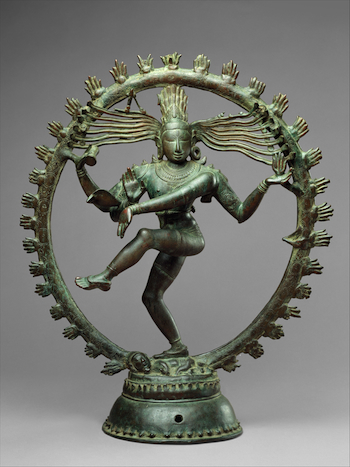Shiva as Lord of Dance (Nataraja). Hindu; India (Tamil Nadu), Chola Dynasty. c. 11th century C.E. Cast bronze

Shiva as Lord of Dance (Nataraja). Hindu; India (Tamil Nadu), Chola Dynasty. c. 11th century C.E. Cast bronze
- The art of medieval India, like the art of medieval Europe, was primarily in the service of religion.
- The devotee’s spiritual experience was enhanced by meditation inspired by works of art and architecture.
- Nataraja”—nata meaning dance or performance, and raja meaning king or lord
- this particular statue was intended to be movable, which explains its moderate size and sizeable circular base, ideal for lifting and hoisting onto a shoulder.
- From the 11th century and onwards, Hindu devotees carried these statues in processional parades as priests followed chanting prayers and bestowing blessings on people gathered for this purpose.
- In a religious Hindu context, the statue is the literal embodiment of the divine. When the worshiper comes before the statue and begins to pray, faith activates the divine energy inherent in the statue, and at that moment, Shiva is present.
- Shiva constitutes a part of a powerful triad of divine energy within the cosmos of the Hindu religion. There is Brahma, the benevolent creator of the universe; there is Vishnu, the sagacious preserver; then there is Shiva, the destroyer.
- In Hindu religious philosophy all things must come to a natural end so they can begin anew, and Shiva is the agent that brings about this end so that a new cycle can begin.
- was made some time in the eleventh century during the Chola Dynasty (9th-13th centuries C.E.)
- One of the longest lasting empires of south India, the Chola Dynasty heralded a golden age of exploration, trade, and artistic development.
- A great area innovation within the arts of the Chola period was in the field of metalwork, particularly in bronze sculpture. The expanse of the Chola empire stretched south-east towards Sri Lanka and gave the kingdom access to vast copper reserves that enabled the proliferation of bronze work by skilled artisans.
- contained a precise set of measurements and shapes for the limbs and proportions of the divine figure.
- Arms were to be long like stalks of bamboo, faces round like the moon, and eyes shaped like almonds or the leaves of a lotus. The Shastras were a primer on the ideals of beauty and physical perfection within ancient Hindu ideology.
- Here, Shiva embodies those perfect physical qualities as he is frozen in the moment of his dance
- The ring of fire that surrounds the figure is the encapsulated cosmos of mass, time, and space, whose endless cycle of annihilation and regeneration moves in tune to the beat of Shiva’s drum and the rhythm of his steps.
- His lower right hand with his palm raised and facing the viewer is lifted in the gesture of the abhaya mudra, which says to the supplicant, “Be not afraid, for those who follow the path of righteousness will have my blessing.”
- Shiva’s lower left hand stretches diagonally across his chest with his palm facing down towards his raised left foot, which signifies spiritual grace and fulfillment through meditation and mastery over one’s baser appetites.
- In his upper left hand he holds the agni (image left), the flame of destruction that annihilates all that the sound of the damaru has drummed into existence.
- Shiva’s hair, the long hair of the yogi, streams out across the space within the halo of fire that constitutes the universe. Throughout this entire process of chaos and renewal, the face of the god remains tranquil
- “perfect expression of rhythmic movement in the world.”
- both cosmic and psychological.
- Bronzes of the Chola period such as Shiva as Lord of the Dance (Nataraja) arose out of a need to transmute the divine into a physical embodiment of beauty.
- incomplete without an understanding of its symbolism and religious significance